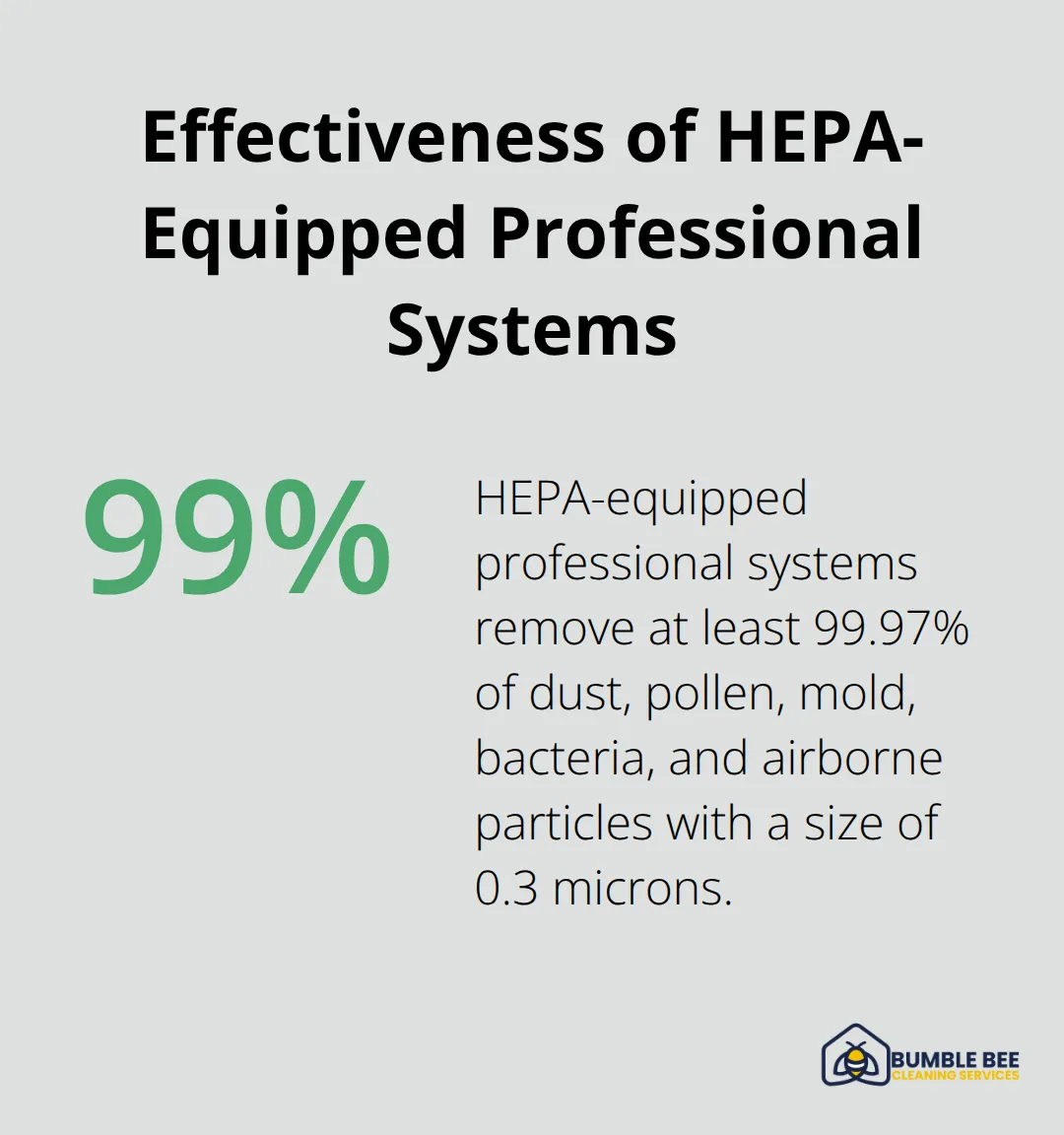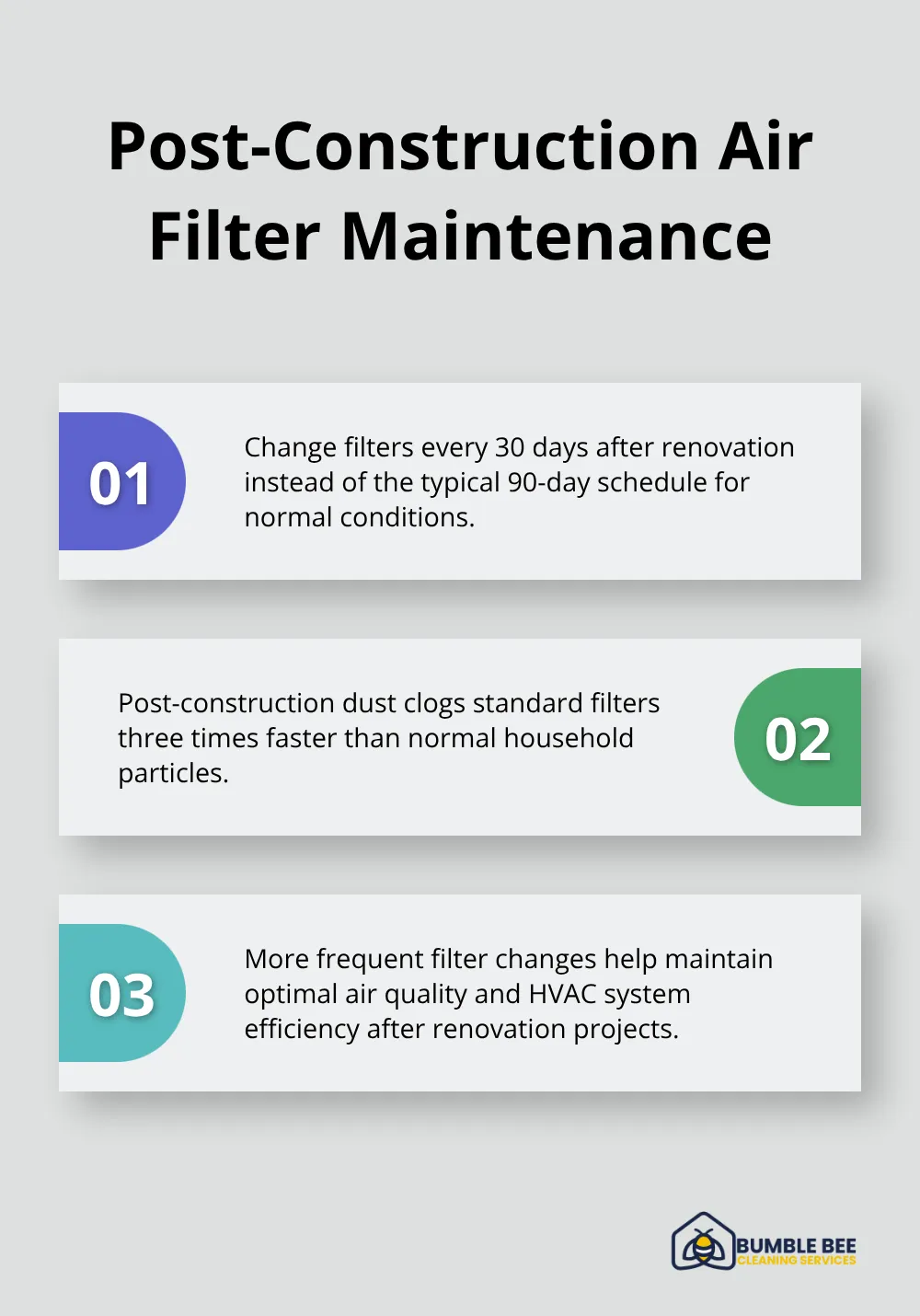Your renovation project is complete, but the air inside your home tells a different story. Post-renovation air often contains harmful particles that can affect your health for weeks or even months.
We at Bumble Bee Cleaning Services see this problem regularly in Seattle homes. The good news is that you can take specific steps to clear the air and protect your family’s wellbeing.
What Pollutants Hide in Your Home After Renovation
Renovation projects release specific contaminants that most homeowners never consider. Drywall dust contains gypsum and silica particles that remain airborne for days (according to the EPA), while wood dust from materials like Western red cedar triggers respiratory issues and allergic reactions as the American Lung Association documents. Paint and solvent residues emit volatile organic compounds that cause headaches and nausea, with the EPA reporting that indoor air pollution reaches levels two to five times higher than outdoor air during renovation periods.

The Silent Threat of Construction Dust
Silica dust poses the greatest danger among renovation pollutants. OSHA identifies this dust, which forms when workers cut concrete or stone, as a major risk factor for silicosis and lung cancer. Fine particulate matter from construction activities can cause premature death, particularly in people with existing heart or lung conditions according to EPA research. Seattle’s damp climate makes drywall dust even more problematic, as moisture causes particles to stick to surfaces and creates ideal conditions for mold spores.
How Long Contaminants Remain in Your Air
Post-renovation pollutants don’t disappear quickly. Fine dust particles continue to settle throughout your home after construction ends. Chemical residues from paints and adhesives off-gas for months, continuously releasing harmful compounds into your air space. The American Lung Association reports that many homeowners experience persistent coughs, wheezing, and shortness of breath weeks after their renovation projects finish (indicating that standard methods fail to address the microscopic particles that matter most for your health).
Now that you understand what contaminants lurk in your post-renovation air, you need immediate action steps to clear these pollutants from your home.
How Can You Clear Post-Renovation Air Fast
Your first move should focus on powerful ventilation that forces contaminated air out while pulling fresh air in. Open windows on opposite sides of your home to create cross-ventilation, and position box fans in windows to blow dirty air outside rather than circulate it indoors. The CDC recommends that you run exhaust fans in bathrooms and kitchens continuously for 48 hours after renovation work ends. Window fans should pull air out of rooms where construction occurred while they draw clean outdoor air through windows in unaffected areas. This approach moves six times more contaminated air than passive ventilation alone.
Test Before You Breathe Easy
Professional air quality tests reveal exactly which contaminants remain in your home after construction. Companies like Air Quality Consultants use particle counters that measure PM2.5 and PM10 levels, while VOC meters detect chemical off-gas from paints and adhesives. Tests cost between $300-500 in Seattle, but they identify specific problems that generic methods miss. NIOSH data shows that homes with professional tests achieve 40% better air quality outcomes compared to those that rely on visual inspection alone. Schedule tests 72 hours after renovation completion when initial dust settles but before contaminants embed deeper into surfaces.
When DIY Methods Fall Short
Call professional services when you experience persistent respiratory symptoms, notice visible dust that resettles daily, or detect chemical odors weeks after project completion. Standard household vacuums capture only 30% of fine construction dust, while HEPA-equipped professional systems remove at least 99.97% of dust, pollen, mold, bacteria, and airborne particles with a size of 0.3 microns. Professional intervention becomes necessary when renovation involved lead paint removal, asbestos disturbance, or extensive drywall work that creates silica dust hazards.

Advanced Equipment Makes the Difference
Professional services use specialized post-construction protocols that include HEPA vacuums, wet techniques for settled particles, and air filtration systems that run continuously during cleanup. These systems capture ultra-fine particles that standard equipment misses entirely. HEPA filtration captures at least 99.97% of particles as small as 0.3 microns, while wet methods prevent dust from becoming airborne again during removal.
Once you’ve addressed immediate air quality concerns, you’ll need strategies that maintain clean air over the long term.
What Keeps Your Air Clean Long-Term
HVAC System Optimization
Your HVAC system becomes your most important ally for clean air maintenance after renovation work ends. Change filters every 30 days instead of the typical 90-day schedule because post-construction dust clogs standard filters three times faster than normal household particles. Install MERV 13 filters which can theoretically remove at least 99.97% of dust, pollen, mold, bacteria, and airborne particles with a size of 0.3 microns (most construction dust that escapes initial cleanup falls within this range). The EPA recommends continuous system operation for two weeks after renovation to cycle all indoor air through filtration at least six times daily. Seattle homes benefit from whole-house air purifier upgrades that integrate with existing HVAC systems and provide constant filtration for particles too small for standard filters.

Plants That Actually Clean Your Air
Snake plants and spider plants remove formaldehyde from paint off-gas while peace lilies absorb benzene and trichloroethylene from adhesives and solvents. While some sources suggest plants can help with air quality, the effectiveness of using plants for air purification in homes remains limited according to current research. Boston ferns excel at xylene removal from wood stains while rubber plants absorb airborne chemicals from synthetic materials. Place plants in rooms where renovation occurred because they work best within 6-8 feet of contamination sources (their effectiveness drops significantly beyond this distance).
Daily Habits That Protect Your Indoor Air
Open windows for 15 minutes each morning even during winter months because outdoor air in Seattle typically contains fewer pollutants than post-renovation indoor air. Vacuum with HEPA-equipped machines twice weekly for the first month after construction, then maintain weekly schedules permanently. Wash bedding in hot water weekly and replace pillows every six months because fabric traps microscopic particles that regular washing cannot remove. Keep humidity between 30-50% with dehumidifiers because higher levels allow dust particles to clump together and settle on surfaces where they become harder to remove through normal cleaning.
Final Thoughts
Post-renovation air quality demands immediate action and consistent long-term strategies. Your health depends on the removal of silica dust, VOCs, and fine particles that standard methods miss. Professional air quality tests reveal specific contaminants while HEPA systems capture 99.97% of harmful particles.
HVAC maintenance with MERV 13 filters, strategic ventilation, and proper humidity control create protection that lasts. When respiratory symptoms persist or dust continues to resettle daily, professional intervention becomes necessary. Post-renovation air problems resolve with the right approach and proper equipment.
We at Bumble Bee Cleaning Services specialize in post-construction cleaning with HEPA equipment and certified techniques that address microscopic particles. Our experience with Seattle homes means we understand which contaminants renovation projects leave behind (and how to eliminate them effectively). Your investment in air quality protection pays dividends in better health and peace of mind for years ahead.
